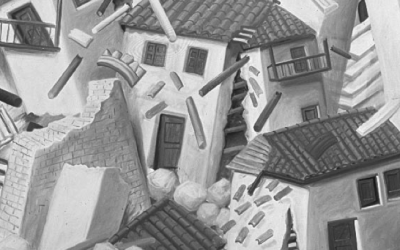The Vanishing Biodiversity of the Brazilian Cerrados
The Cerrados are a mosaic of savannas, grasslands, and tropical dry forests that once covered about one-fifth of Brazil, an area the size of Alaska. Among the world’s oldest and most diverse tropical ecosystems, they rival Amazonia in species diversity. Despite their ecological importance the Cerrados have received much less attention from conservationists and international media and at present are one of the most threatened ecosystems of Brazil. According to a recent study of Conservation International, they may disappear by 2030.
During my summer internship funded by the Rockefeller Center for Latin American Studies, I had the opportunity to study this wonderful ecosystem. At first, I was astounded by the diversity of its flora and fauna. We tend to associate lush, dense tropical wet forests with high biodiversity. However, I was able to see first-hand how a dry environment, such as the Cerrados, can be home to a multitude of plants and animals. Sadly, I also found out how the Brazilian government continues to undervalue and fail to protect this ecosystem.
Until the late 1950’s the Cerrados could be found from the south of Brazil until Amazonia. During this period governmental policies encouraged migration to the central areas of Brazil in order to promote the development in this unpopulated part of the country. Together with this burst in human population came the uncontrolled expansion of agricultural activities in the region, which in turn dramatically increased the destruction of the natural vegetation cover. Today, deforestation and natural and anthropogenic fires have decreased the Cerrados’ original area by more than one half, and it may be that half of these remaining areas are no longer appropriate for biodiversity conservation.
I developed my research project in one of these reserves, the Ecological Reserve do IBGE. Located only 22 miles from downtown Brasilia, it is equipped with good quality lab facilities; its location near the University of Brasilia provides advantageous conditions to do research in the Cerrado ecosystem.
As a first year graduate student at the Harvard Biology department interested in studying how drought events influence the distribution and abundance of trees in tropical forests, the Cerrado climate regime and vegetation could not be more attractive. This ecosystem experiences a severe limitation in water availability, having a low relative humidity and a pronounced dry season from June to October when there is almost no precipitation.
According to some global climate models human-driven increase of CO2 concentrations in the atmosphere will increase the frequency of drought in some tropical forests around the world. The field experiments that I developed this summer shed some light on the physiological strategies that tropical trees employ to deal with water stress conditions. This kind of study is helping us to understand how trees would face such drought events. In turn it provides conservationists and environmental managers with better tools to identify the appropriate steps to protect these ecosystems from anthropogenic activities.
Although some protected areas like these are helping to conserve the Cerrados, still more efforts are needed. Only 2% of the Cerrados are under protection in comparison with 12% of the Amazon. Moreover, while the Brazilian constitution considers other tropical biomes such as Amazonia, Pantanal and Mata Atlantica as National patrimony, the Cerrados still do not have this status, hampering the work required to conserve this ecosystem.
Hopefully in the near future the Brazilian government working together with conservationists and local communities will recognize the importance of the Cerrados and create more protected areas, making it possible to conserve its great biodiversity under the new global climate conditions of the Anthropocene geological period. Certainly this task will not be accomplished without massive education programs to make the local and international community realize how valuable the Cerrados are and how urgent is the need to protect them.
Winter 2007, Volume VI, Number 2
Juan Pablo Giraldo is a first-year graduate student in the Harvard Biology department. He received a DRCLAS internship grant to go to Brazil.
Related Articles
Editor’s Letter: Natural Disasters
We were little black cats with white whiskers and long tails. One musical number from my one and only dance performance—in the fifth grade—has always stuck in my head. It was called “Hernando’s Hideaway,” a rhythm I was told was a tango from a faraway place called Argentina.
After the Earthquake: Juan’s Life
Juan was a construction helper. He lived in Armenia, but his parents were from the Antioquia region, who had fled because of the violence there. The mother of his children was called…
Political Memory
Late in 1717 Dr. Joseph Surin, precentor of the Cathedral of Old Guatemala, carried out some calculations: had the mudslide that wiped the city on the 28th of August, feast day of Saint…




